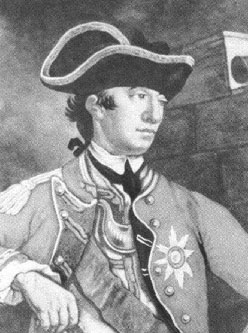| William Howe  Born: 10-Aug-1729 Born: 10-Aug-1729
Birthplace: England
Died: 12-Jul-1814
Location of death: Plymouth, Devon, England
Cause of death: unspecified
Remains: Buried, Holly Road, Twickenham, England
Gender: Male
Race or Ethnicity: White
Occupation: Military Nationality: England
Executive summary: Commander-in-Chief in America Military service: British Army William Howe, 5th Viscount Howe, British general, was the younger brother of George Augustus, killed in the Ticonderoga expedition of 1758, and of Richard, 4th Viscount and afterwards Earl Howe, the admiral. He entered the cavalry in 1746, becoming a lieutenant a year later. On the disbanding of his regiment in 1749 he was made captain-lieutenant and shortly afterwards captain by Lord Bury's (20th) regiment, in which Wolfe was then a field officer. Howe became major in 1756 and lieutenant colonel in 1757 of the 58th (now Northampton) regiment, which he commanded at the capture of Louisburg. In Wolfe's expedition to Quebec he distinguished himself greatly at the head of a composite light battalion. He led the advanced party in the landing at Wolfe's Cove and took part in the battle of the Plains of Abraham which followed. He commanded his own regiment in the defense of Quebec in 1759-60, led a brigade in the advance of Montreal and took part on his return to Europe in the siege of Belleisle (1761). He was adjutant-general of the force which besieged and took Havana in 1762, and at the close of the war had acquired the reputation of being one of the most brilliant of the junior officers of the army. He was made colonel of the 46th foot in 1764 and lieutenant-governor of the Isle of Wight four years later. From 1758 to 1780 he was M.P. for Nottingham. In 1772 he became major-general, and in 1774 he was entrusted with the training of light infantry companies on a new system, the training-ground being Salisbury Plain.
Shortly after this he was sent out to North America. He did not agree with the policy of the government towards the colonists, and regretted in particular that he was sent to Boston, where the memory of his eldest brother was still cherished by the inhabitants, and General Thomas Gage, in whom he had no confidence, commanded in chief. He was the senior officer after Gage, and led the troops actively engaged in the storming of Bunker Hill, he himself being in the thickest of the fighting. In the same year Howe was made K.B. and a lieutenant general, and appointed, with the local rank of general, to the chief command in the seat of war. He retained it until May 1778 -- on the whole with success. The cause of his registration was his feeling that the home government had not afforded the proper support, and after his return to England, he and his brother engaged in a heated but fruitless controversy with the ministers. Howe's own defense is embodied in the Narrative of Sir William Howe before a Committee of the House of Commons (London, 1780). In 1782 Howe was made lieutenant-general of the ordnance; in 1790 he was placed in command of the forces organized for action against Spain, and in 1793 he was made a full general. He held various home commands in the early part of the French revolutionary war, in particular that of the eastern district at the critical moment when the French established their forces on the Dutch coast. When Earl Howe died in 1799, Sir William succeeded to the Irish viscounty. He had been made governor of Berwick-on-Tweed in 1795, and in 1805 became governor of Plymouth, where he died on the 12th of July 1814. With his death the Irish peerage became extinct. Father: Emmanuel Scrope Howe, 2nd Viscount Howe (d. 1735)
Mother: Mary Sophia Charlotte
Brother: George Augustus Howe (d. 1758)
Brother: Richard Howe, 4th Viscount Howe (d. 1799)
High School: Eton College
UK Member of Parliament 1758-80
Knight of the British Empire 1775
English Ancestry
Requires Flash 7+ and Javascript.
Do you know something we don't?
Submit a correction or make a comment about this profile
Copyright ©2019 Soylent Communications
|